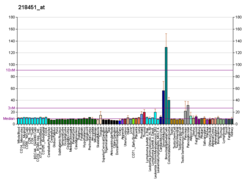Function
CDCP1 is a 140 kD transmembrane glycoprotein with a large extracellular domain (ECD) containing two CUB domains, and a smaller intracellular domain (ICD). CDCP1 is cleaved by serine proteases at the extracellular domain next to Arg368 to generate a truncated molecule of 80 kDa size. [7] Different cell lines express different amounts of p140 and p80, depending on the activity of endogenous serine proteases.
The intracellular domain of CDCP1 contains five tyrosine residues - Y707, Y734, Y743, Y762 and Y806. The tyrosine phosphorylation of CDCP1 in cultured cells occurs when cells are induced to detach by trypsin or EDTA, or seen spontaneously during mitotic detachment.
This page is based on this
Wikipedia article Text is available under the
CC BY-SA 4.0 license; additional terms may apply.
Images, videos and audio are available under their respective licenses.




